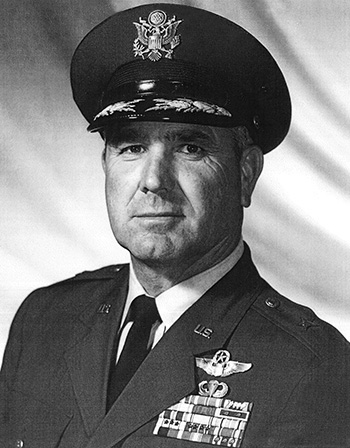
|
Frank J. Collins |
 |
|||
| Rank, Service | ||||
Brigadier General O-7, U.S. Air Force |
||||
| Veteran of: | ||||
|
||||
| Tribute: | ||||
Frank Collins was born on June 19, 1918, in Caddo, Texas. He enlisted in the U.S. Army Reserve on July 17, 1934, and served until July 16, 1937. After attending Texas Wesleyan College, he enlisted in the Aviation Cadet Program of the U.S. Army Air Forces on January 17, 1942, and was commissioned a 2d Lt and awarded his pilot wings at Kelly Field, Texas, on September 6, 1942. Lt Collins then served as a P-40 Warhawk and P-47 Thunderbolt pilot with the 319th Fighter Squadron of the 325th Fighter Group at Hartford, Connecticut, from October 1942 to January 1943, and then deployed to North Africa and the Mediterranean Theater from January 1943 to March 1944. During this time, Maj Collins was credited with the destruction of 9 enemy aircraft in aerial combat, plus 1 probable and 1 damaged in the air. After returning to the United States and taking leave, he was assigned as Commander of the 464th Fighter Squadron of the 507th Fighter Group in October 1944, serving in Colorado, Nebraska, and Texas, before deploying to Ie Shima Airfield, Okinawa, from June 1945 until he was forced to bail out of his stricken P-47 on July 10, 1945. After spending 2 days in the water, he was captured and taken as a Prisoner of War by the Japanese on July 12, 1945, and was held at the Tokyo POW Camp in Japan until he was repatriated in September 1945. After recuperating from his injuries, Col Collins served as a test pilot with the first Jet Aircraft Development Program, followed by service as an exchange pilot with the Royal Air Force in England. His next assignment was as an F-84 Thunderjet pilot and Commander of the 526th Fighter-Bomber Squadron of the 86th Fighter-Bomber Group at Neubiberg AB, West Germany, from June to November 1951, followed by service as Deputy Commander of the 86th Fighter-Bomber Group at Neubiberg from November 1951 to January 1952. He served as Executive Officer and then Deputy Commander of the 12th Fighter-Escort Wing at Bergstrom AFB, Texas, from January to December 1952, and then served on the Operations Staff with Headquarters U.S. Air Force in the Pentagon from December 1952 to September 1955. Col Collins next served as Base Commander at Edwards AFB, California, from September 1955 to October 1957, followed by service as Assistant Director of Operations with Headquarters 5th Air Force at Fuchu AS, Japan, from October 1957 to January 1958. He was Commander of the Provisional Flying Training Wing at Misawa AB, Japan, from January to June 1958, and then served as Commander and then Director of Operations of the 21st Tactical Fighter Wing at Misawa from July 1958 to May 1960. His next assignment was as Deputy Commander for Operations of the 39th Air Division at Misawa AB from May to September 1960, followed by service as an Air Force Advisor to the Ohio Air National Guard, where he served with the 121st Tactical Fighter Wing at Lockbourne AFB, Ohio, from September 1960 to October 1961. Col Collins served as an F-100 Super Sabre pilot and Commander of the 31st Tactical Fighter Wing at George AFB, California, and then Homestead AFB, Florida, from October 1961 to March 1964, and then as Commander of the 366th Tactical Fighter Wing at Holloman AFB, New Mexico, from March 1964 to July 1965. Gen Collins' final assignment was as Commander of the 836th Air Division at MacDill AFB, Florida, from July 1965 until his retirement from the Air Force on September 1, 1967. Frank Collins died on December 13, 2000, and was buried at the Fort Sam Houston National Cemetery in San Antonio, Texas. |
||||
|
||||

